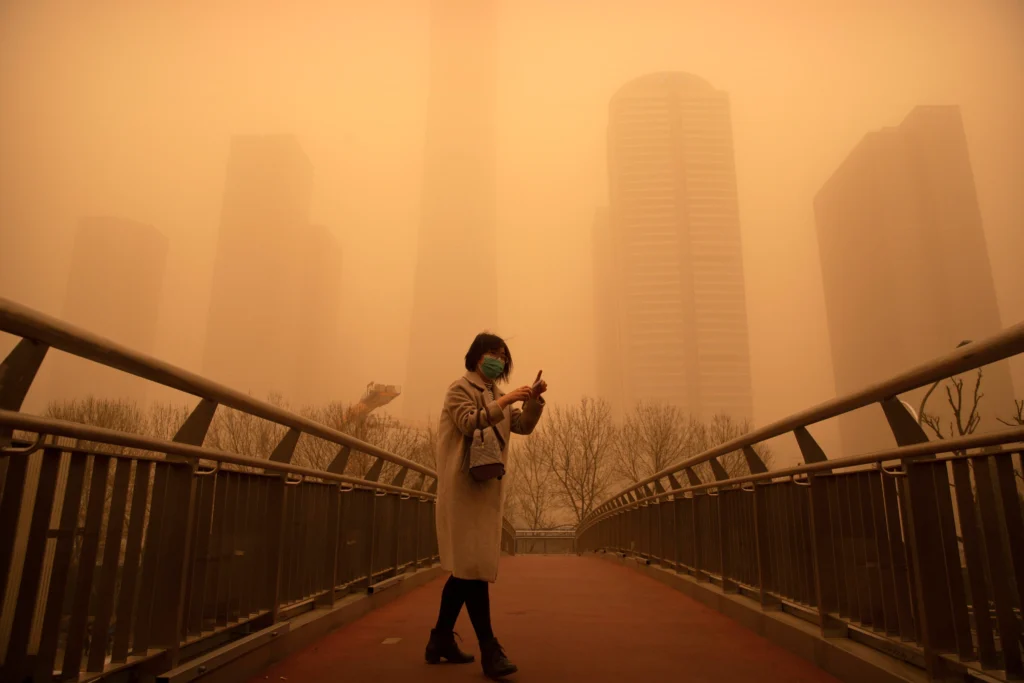New CREA Report Reveals China Misses Air Quality Goals as Their Economy Takes Priority

- Half of targeted cities missed the PM2.5 targets in 2023 Q4, while 41% of cities missed those in 2024 Q1. Except for Luliang in Shanxi province, all other cities that had year-on-year increases in these time periods are located within the Beijing region.
- Overall PM2.5 decreased by 1.6% year-on-year nationally in the autumn and winter of 2023-2024, though not fully counteracting the rebound in the same time period of 2022-2023. To do so, an additional 3.1% year-on-year decrease would be needed.
- Cities in Henan province within the Beijing region topped the most polluted cities due to PM2.5 in the past autumn and winter, with 7 out of 10 top polluted cities in Henan. Anyang in Henan ranked first with an average concentration of 72.7 ug/m3, exceeding the World Health Organization (WHO) recommended value by 15 times.
- Without more favourable weather this past autumn and winter, PM2.5 would have been boosted due to emissions rising by 5.7% in 2023 Q4. 2024 Q1 saw a decrease in emission-attributable year-on-year change in PM2.5 pollution level after the ‘Winter action plan’ was enforced.
- Cities that saw decreases in emission-attributable pollution in 2024 Q1 were concentrated close to the capital. Cities that saw emissions’ contributions rise were located in Henan and other provinces that are farther away from Beijing.
- Decreases in cement and raw coal production contributed to less emission-attributable pollution in 2024 Q1, while intensified thermal power, non-ferrous metal and petrochemical production could have counteracted part of the benefit.
Introduction: ‘Winter action plan’ back in public’s sight after one-year break
The ‘Winter action plan’, for 2023-2024 (‘Comprehensive Action Plan for Autumn and Winter Air Pollution Control in Beijing-Tianjin-Hebei area and Fenwei Plain’) was released in December 2023, after a one-year hiatus. Without enforcing it for 2022-2023, PM2.5 rose rapidly by 4.7% year-on-year on the national average in the autumn and winter seasons from October to March. For the same time period in 2023-2024, national PM2.5 levels decreased by 1.6% year-on-year, although still not counteracting the increase that occurred in 2022-2023.
The Winter action plan was first introduced in 2017 by the Chinese central government as a gatekeeper for the end of its ‘Ten Articles on Air Quality’ policy that had a target of decreasing PM2.5 by 10% from 2012 to 2017. Usually every autumn, the plan is released and rolls out city targets on PM2.5 concentrations and on the number of heavily polluted days. It also provides specific guidance to control pollution emissions in industrial and energy sectors. The plan was focussed on the Beijing-Tianjin-Hebei region (‘Beijing region’) and Fenwei Plain region (‘Xi’an region’).
Since PM2.5 and the occurrence of heavily polluted days typically peak in autumn and winter, these seasons are a critical time for addressing air pollution in China. Industrial emissions, coal production and winter heating by coal, coupled with poorer atmospheric dispersion conditions due to temperature inversions in winter, have led to severe smog problems, especially in the north. In 2022, industrial emissions accounted for 62% of the particulate matter emissions in the whole country, with coal mining, metal processing, and power generation industries being the highest emitters. Sandstorms and traffic exhaust are important winter contributing factors as well.
The Winter action plan for 2022-2023 went missing from the public’s sight in 2022. While enforcement of the plan was lacking, PM2.5 levels soared, especially in the first quarter of 2023, increasing 7.0% year-on-year on national average. The capital Beijing even saw an increase by 30.6% during the same time. The escalation of pollution in early 2023 had a significant impact on the rebound of the annual average for the year. Consequently, the autumn and winter of 2023-24 became a critical time to end the pollution trend.
For autumn and winter air pollution controls in 2023-2024, the Winter action plan came back later than usual in late December of 2023, when the first half of the evaluation period had already almost passed. This delay could be justified to align with a national air control policy that was introduced in November. Introducing autumn-winter control measures in the last quarter of the year may also have been seen as a risk to the local governments for realising their economic targets for 2023. The delay in publishing city targets and specific control measures could have led to neglecting air pollution control needs in the first half of winter. In fact, before the policy went into effect, PM2.5 increased nationally by 0.9% year-on-year in Q4 of 2023, while it decreased by 3.6% in Q1 of 2024.
Half of targeted cities missed the PM2.5 targets
Compared to the national average, Beijing and Xi’an regions both had a bigger decrease in PM2.5 levels in the past autumn and winter. However, combined, half of targeted cities missed the PM2.5 targets in 2023 Q4, while 41% of cities missed those in 2024 Q1. In addition, 39% of cities missed the targets for limiting the number of severely polluted days (AQI greater than 200) in 2023 Q4, while 20% of cities missed those in 2024 Q1.
Among them, cities in the Xi’an region had better compliance rates than those of the Beijing region. 23% and 61% of cities in Xi’an and Beijing regions, respectively, exceeded the PM2.5 targets for 2023 Q4, while 15% and 50% of cities in Xi’an and Beijing regions exceeded those for 2024 Q1. Cities with the highest year-on-year increase in PM2.5 are mostly concentrated in Shandong and Hebei provinces in the Beijing region (Figure 1).

Figure 1. Top ten cities with largest discrepancy between actual concentrations and PM2.5 targets for autumn-winter 2023-24
Except for the top ranking Luliang, which had the largest year-on-year increase and also exceeded the most targets, the other 19 cities that had year-on-year increases in 2023 Q4 are all located within the Beijing region, including Beijing. However, most of them managed to decrease year-on-year in 2024 Q1, except for Rizhao (of Shandong) and Shangqiu (of Henan), which increased year-on-year by 3.0% and 2.0%, respectively.
7 out of 10 top cities polluted by PM2.5 during evaluation period were in Henan province
In 2023 Q4 and 2024 Q1, the cities that had the worst PM2.5 pollution, meaning their PM2.5 concentrations in absolute value were the largest, seven out of the top 10 cities were in Henan province within the Beijing region. The top one, Anyang of Henan, had the largest average PM2.5 concentration of 72.7 ug/m3 in 2023 Q4 and 2024 Q1, exceeding the WHO recommended value by 15 times.

Figure 2. Top ten cities with the highest average PM2.5 concentrations for autumn-winter 2023-24
Among the most polluted cities, Shangqiu in Henan province also experienced the most severe pollution episode during this period. From 5 to 11 February 2024, the seven-day average concentration of PM2.5 in Shangqiu reached 180 ug/m3, which is five times the national standard, and 36 times the recommended level by the World Health Organization. Another three Henan cities also had the most severe episodes during the past autumn and winter (Table 1).
| Table 1. Top 5 cities with highest 7-day PM2.5 average concentrations2023 Q4 to 2024 Q1 | ||||
| City | 7-days average of PM2.5 (ug/m3) | Term | Start date | End date |
| Shangqiu, Henan | 180.0 | 2024 Q1 | 05/02/2024 | 11/02/2024 |
| Anyang, Henan | 173.4 | 2024 Q1 | 05/02/2024 | 11/02/2024 |
| Xinxiang, Henan | 168.0 | 2024 Q1 | 06/02/2024 | 12/02/2024 |
| Luohe, Henan | 164.3 | 2024 Q1 | 08/01/2024 | 14/01/2024 |
| Xianyang, Shaanxi | 160.8 | 2023 Q4 | 24/12/2023 | 30/12/2023 |
| Data source: real-time air quality data released by the Ministry of Ecology and Environment of China | ||||
More favourable weather conditions contributed the most to decreasing PM2.5
The timing of policy implementation during the past autumn and winter had an observable impact on air quality. After excluding weather influences from the pollution level results, a significant decrease of pollution year-on-year in 2024 Q1 from 2023 Q4 was attributable to changes in emissions. The pollution level attributable to emissions increased 5.7% year-on-year on average for all cities in 2023 Q4, while it went down 4.3% in 2024 Q1.
Favourable weather conditions contributed to the year-on-year decrease of PM2.5 pollution levels by 9.1% and 4.5% in 2023 Q4 and 2024 Q1, respectively. In general, weather influences had a higher contribution to decreasing pollution levels in the past autumn and winter than emission changes. Without favourable weather conditions, pollution may have risen significantly by the end of 2023, and the decrease in early 2024 may also have been lower.
Comparing the differences in emission-attributable year-on-year changes in PM2.5, 22% of cities saw increases from 2023 Q4 to 2024 Q1, and the others saw decreases. 29% of cities changed direction in emission contributions from increasing to decreasing from 2023 Q4 to 2024 Q1, while 6% of cities saw the opposite.
Cities close to Beijing saw decreasing emissions
Cities that had the largest changes in air pollution between the year-on-year ratios of 2023 Q4 and 2024 Q1, turning from increasing to decreasing, were concentrated in the Beijing region: Tangshan (of Hebei), Qinhuangdao (of Hebei), Tai’an (of Shandong), Luliang (of Shanxi) and Langfang (of Hebei). It appears that cities closer to the capital centre had larger decreases in emissions’ contribution in 2024 Q1. On the other hand, Henan province is the farthest from Beijing in the key region, and may have looser air pollution controls. Luoyang (of Henan)’s year-on-year change in PM2.5 due to emissions increased from -11.8% to 0.8% in 2024 Q1. The other cities that saw increases were also concentrated in Henan, Shaanxi and Shanxi provinces.

Figure 3 (a). Year-on-year change in PM2.5 concentrations of cities in Beijing and Xi’an regions in 2023 Q4

Figure 3 (b). Year-on-year change in PM2.5 concentrations of cities in Beijing and Xi’an regions in 2024 Q1
Changes in thermal power and industrial production drove pollution changes
The decrease in cement production and raw coal production contributed to less emission-attributable increases in pollution in 2024 Q1 than in 2023 Q4, while intensified thermal power, chemical products and non-ferrous metal production counteracted part of the improvement. The year-on-year increases of thermal power production were larger in all provinces within the Beijing and Xi’an regions, except for Hebei, in 2024 Q1, when compared to 2023 Q4. On the other hand, cement production and raw coal production increased more year-on-year in 2023 Q4. Non-ferrous metals production increased greatly in Hebei, by 161.6% in 2023 Q4, while it increased more in the Xi’an region in 2024 Q1. Chemical-related industries experienced noticeable year-on-year growth, especially in Shanxi, Hebei and Henan provinces, though the increase slowed down in 2024 Q1. Overall, thermal power generation, non-ferrous metal production, and chemical product manufacturing were significant sources of industrial emissions during this autumn and winter period. Additionally, transportation data reflects a rebound trend in the past autumn and winter, with freight volume and passenger traffic increasing year-on-year.
| Table 2. Year-on-year changes of key industrial outputs in provinces within Beijing and Xi’an regions2023 Q4 and 2024 Q1 | ||||||||
| Phase | Region | Province | Thermal power | Plastics in primary forms | Chemical fibres | Raw coal | Non-ferrous metals | Cement |
| 2023 Q4 | Beijing region | Beijing | -2% | -5% | 0% | – | – | -15% |
| Tianjin | 7% | 6% | 0% | – | – | -10% | ||
| Hebei | 9% | 7% | 24% | 0% | 162% | 1% | ||
| Shandong | 1% | 14% | 46% | 3% | 12% | -1% | ||
| Henan | 5% | 17% | 49% | 3% | 5% | -10% | ||
| Xi’an region | Shanxi | 3% | 26% | 414% | 0% | 2% | 4% | |
| Shaanxi | 11% | -5% | -10% | 2% | -4% | -8% | ||
| 2024 Q1 | Beijing region | Beijing | 1% | -5% | -33% | – | – | 4% |
| Tianjin | 6% | -4% | 0% | – | – | -20% | ||
| Hebei | 6% | 21% | 21% | -3% | 41% | -14% | ||
| Shandong | -1% | -4% | 40% | 3% | 1% | -13% | ||
| Henan | 11% | 32% | 4% | 3% | 8% | -24% | ||
| Xi’an region | Shanxi | 4% | -2% | 279% | -19% | 11% | -33% | |
| Shaanxi | 12% | 2% | -12% | 0% | 6% | 0% | ||
| Data source: Chinese government data through Wind Financial Terminal | ||||||||
Lax enforcement must be overridden by timely introduction of air pollution winter plans going forward
In 2023, the local governments faced debt risks and budgetary pressures due to the shrinking real-estate sector and adjustments in economic structure. How to make the transition into a new growth model to tackle both tasks of economic growth and environmental protection has become the focus of attention both domestically and internationally.
The Winter action plan has been effective in controlling heavy pollution by setting short-term targets during peak seasons for regions with higher risk. It has also been an important measure to keep China on track to realise its long-term goals of improving air quality. However, the lack of enforcing the plan in 2022, and introducing it late in 2023 imply that the air pollution control actions may have been deprioritized. This has led to negative results, as shown by the fact that PM2.5 levels rebounded when the guidance was missing.
In 2023, PM2.5 increased year-on-year on national average by 3.4%, and this rebound of air pollution moved China further away from realising its air pollution control target. To realise the 2025 targets given in China’s newest national clean air plan, from 2024 to 2025, the national average PM2.5 has to come down by 1.0%, and the PM2.5 levels in key control regions around Beijing, Xi’an, and Shanghai have to come down by 5.4%, 4.9% and 4.6%, respectively, based on 2023 levels. While Beijing and Xi’an regions PM2.5 levels decreased last year, a yearly increase of 3.2% was observed in the Shanghai region. This suggests air pollution controls may have been loosened after the annual PM2.5 concentration in the Shanghai region fell and stayed below the national standard starting in 2021.
Policy recommendations
To mitigate the PM2.5 pollution issue across China, air pollution policy enforcement should be strengthened. Because the pollution level was relatively the worst in Henan province within the northern key control regions in autumn-winter 2023-2024, pollution formation science should be further examined and mitigation plans should be carried out in Henan province. Based on the overall rebound in 2023, the Shanghai region should also be included for further strengthening of air pollution control policies, to avoid pollution levels from rising.
Improving air quality is essential for human health. The first and second stages of China’s clean air act contributed to the gain of life expectancy of 1.94 to 3.87 months, respectively. Building upon China’s continuous reduction of pollutant levels over the years, moving towards stricter pollution standards and implementing sustained and in-depth governance will bring greater health benefits to local populations.
Related Article: Salesforce Unveils Sustainable AI Policy Principles and Climate-Focused Initiatives
CREA has also projected the latest national clean air plan would avoid approximately 180,000 deaths related to PM 2.5 pollution per year by 2025, compared with the situation in 2020. The largest benefits accrue to the Beijing and Xi’an regions, which have the strongest pollution reduction targets. Controlling air pollution is meaningful also in inducing an overall cleaner development mode. The clean air policy should be considered as a catalyzer for China’s green development.












